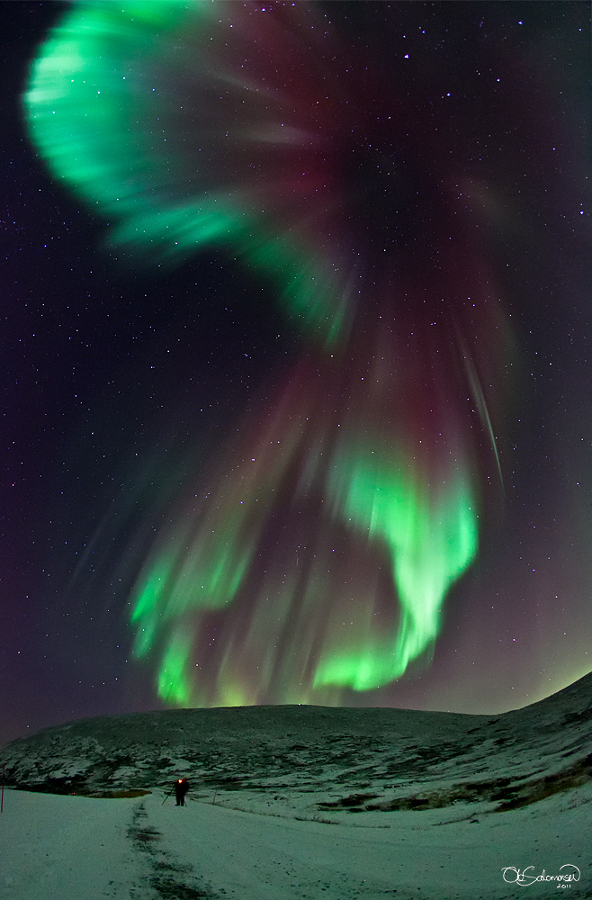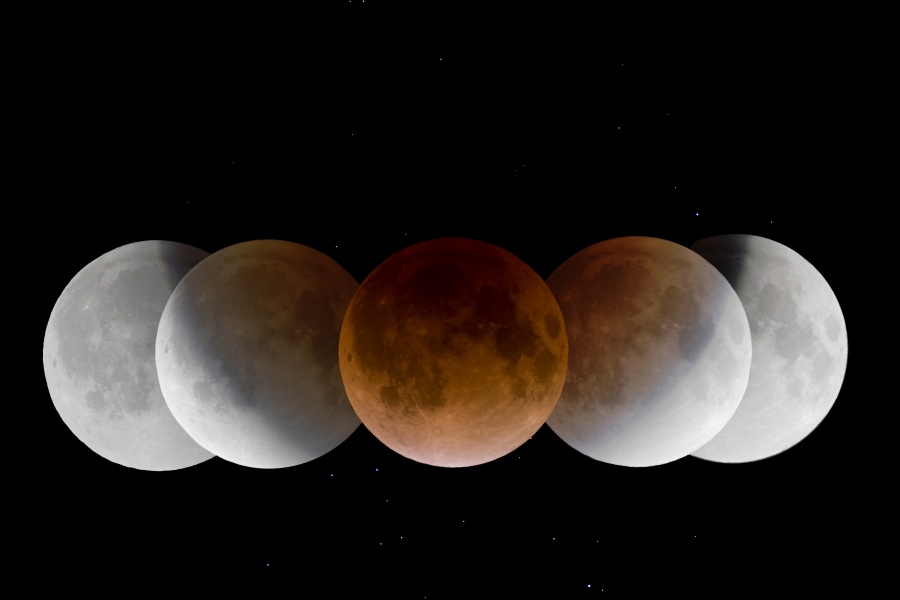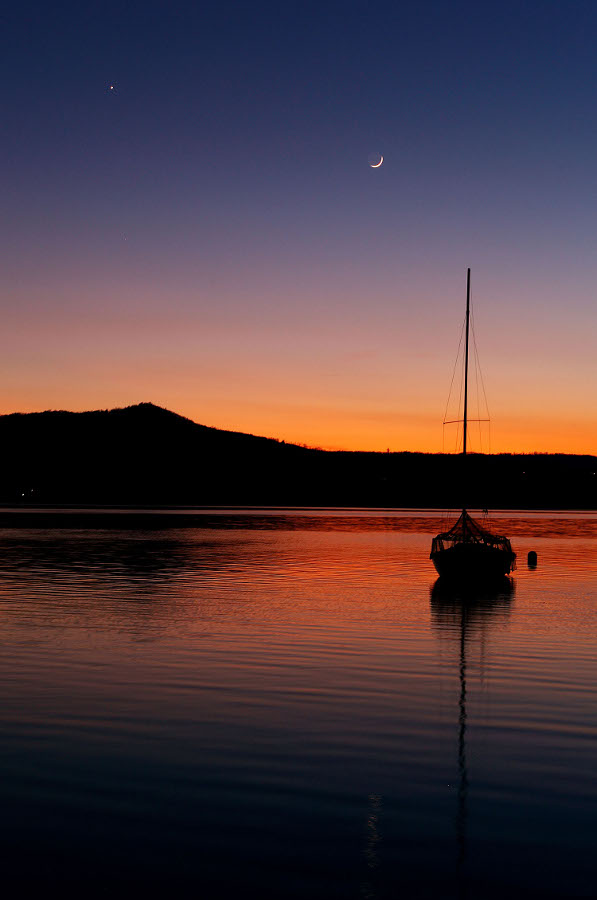_____________________________________________________________________
Please vote for the two best APODs (image and text) for December, 2011. All titles are clickable and link to the original APOD page.
We ask for your help in choosing an APOM, as this helps Jerry and Robert create "year in APOD images" review lectures and a free PDF calendar at year's end, and provides feedback on which images and APODs were relatively well received.
We are very interested to know why you selected the APODs for which you voted; if you would like to tell us, please reply to this thread. Thank you!
Thank you!
_____________________________________________________________________
<- Previous month's poll
A single, long exposure captured these star trails above a remarkably colorful sea of clouds. As seen from Medvednica mountain, the surrounding peaks and lights illuminating the clouds from below are north of Zagreb, Croatia. Near the center of the also colorful star trail arcs, the North Celestial Pole is off the upper right edge of the frame. Even though this is the age of the digital camera, the well composed skyscape was recorded using color slide film in a medium format camera. The dreamlike scene's starry sky and ephemeral ocean could be reminiscent of an older age still, when the Pannonian Sea covered this part of central Europe some 10 million years ago.
It was one of the most memorable auroras of the season. There was green light, red light, and sometimes a mixture of the two. There were multiple rays, distinct curtains, and even an auroral corona. It took up so much of the sky. In the background were stars too numerous to count, in the foreground a friend trying to image the same sight. The scene was captured with a fisheye lens around and above Tromsø, Norway, last month. With the Sun becoming more active, next year might bring even more spectacular aurora.
Strange shapes and textures can be found in neighborhood of the Cone Nebula. The unusual shapes originate from fine interstellar dust reacting in complex ways with the energetic light and hot gas being expelled by the young stars. The brightest star on the right of the above picture is S Mon, while the region just below it has been nicknamed the Fox Fur Nebula for its color and structure. The blue glow directly surrounding S Mon results from reflection, where neighboring dust reflects light from the bright star. The red glow that encompasses the whole region results not only from dust reflection but also emission from hydrogen gas ionized by starlight. S Mon is part of a young open cluster of stars named NGC 2264, located about 2500 light years away toward the constellation of the Unicorn (Monoceros). The origin of the mysterious geometric Cone Nebula, visible on the far left, remains a mystery.
The dark, inner shadow of planet Earth is called the umbra. Shaped like a cone extending into space, it has a circular cross section most easily seen during a lunar eclipse. For example, last Saturday the Full Moon slid across the southern half of Earth's umbral shadow, entertaining moonwatchers around much of the planet. In the total phase of the eclipse, the Moon was completely within the umbra for 51 minutes. Recorded from Beijing, China, this composite eclipse image uses successive pictures from totality (center) and partial phases to trace out a large part of the umbra's curved edge. Background stars are visible in the darker eclipse phases. The result shows the relative size of the shadow's cross section at the distance of the Moon, as well as the Moon's path through Earth's umbra.
NGC 253 is not only one of the brightest spiral galaxies visible, it is also one of the dustiest. Discovered in 1783 by Caroline Herschel in the constellation of Sculptor, NGC 253 lies only about ten million light-years distant. NGC 253 is the largest member of the Sculptor Group of Galaxies, the nearest group to our own Local Group of Galaxies. The dense dark dust accompanies a high star formation rate, giving NGC 253 the designation of starburst galaxy. Visible in the above photograph is the active central nucleus, also known to be a bright source of X-rays and gamma rays.
What's large and blue and can wrap itself around an entire galaxy? A gravitational lens mirage. Pictured above, the gravity of a luminous red galaxy (LRG) has gravitationally distorted the light from a much more distant blue galaxy. More typically, such light bending results in two discernible images of the distant galaxy, but here the lens alignment is so precise that the background galaxy is distorted into a horseshoe -- a nearly complete ring. Since such a lensing effect was generally predicted in some detail by Albert Einstein over 70 years ago, rings like this are now known as Einstein Rings. Although LRG 3-757 was discovered in 2007 in data from the Sloan Digital Sky Survey (SDSS), the image shown above is a follow-up observation taken with the Hubble Space Telescope's Wide Field Camera 3. Strong gravitational lenses like LRG 3-757 are more than oddities -- their multiple properties allow astronomers to determine the mass and dark matter content of the foreground galaxy lenses.
It is one of the largest and longest lived storms ever recorded in our Solar System. First seen late last year, the above cloud formation in the northern hemisphere of Saturn started larger than the Earth and soon spread completely around the planet. The storm has been tracked not only from Earth but from up close by the robotic Cassini spacecraft currently orbiting Saturn. Pictured above in false colored infrared in February, orange colors indicate clouds deep in the atmosphere, while light colors highlight clouds higher up. The rings of Saturn are seen nearly edge-on as the thin blue horizontal line. The warped dark bands are the shadows of the rings cast onto the cloud tops by the Sun to the upper left. A source of radio noise from lightning, the intense storm may relate to seasonal changes as spring slowly emerges in the north of Saturn.
While Comet Lovejoy entertained early morning risers in the southern hemisphere, a lovely conjunction of a young crescent Moon and Venus graced western skies at sunset. Captured on December 26th the conjunction, with beautiful sunset colors above and below, is seen here over Viverone Lake near Turin, Italy. But if you've been outdoors at all lately enjoying sunsets on planet Earth, then you've probably noticed Venus low in the west as the season's brilliant evening star. Sometimes mistaken for a terrestrial light near the horizon, Venus is the third brightest celestial beacon, after the Sun and Moon. That distinction is particularly easy to appreciate in this peaceful scene.
<- Previous month's poll
Poll: Astronomy Picture of the Month for 2011 December
Poll: Astronomy Picture of the Month for 2011 December
Know the quiet place within your heart and touch the rainbow of possibility; be
alive to the gentle breeze of communication, and please stop being such a jerk. — Garrison Keillor
alive to the gentle breeze of communication, and please stop being such a jerk. — Garrison Keillor
-
lenna
Re: Poll: Astronomy Picture of the Month for 2011 December
The memorable aurora over Norway is so beautiful and full of stars and gorgeous color.
The conjunction at sunset . . . is so simple and true. This is why I voted for these images. Thanks for the beauty you share with us.
The conjunction at sunset . . . is so simple and true. This is why I voted for these images. Thanks for the beauty you share with us.
Re: Poll: Astronomy Picture of the Month for 2011 December
Of all the Aurora images I've seen, this is in the top 3, if not the single best, so it won my vote.
A Horseshoe Einstein Ring from Hubble won my 2nd vote, simply this is science verification shown for everyone to grasp, how cool!
A Horseshoe Einstein Ring from Hubble won my 2nd vote, simply this is science verification shown for everyone to grasp, how cool!
Mike R, P.E. .....iMac 27"(i7), iPad2, iPhone5s, 24" iMac, AppleTV(160), MacBook
Canon: 70D + lens:70-200 L f2.8 IS II / TC 1.4x 2x / 11-16 / 15-85 / f1.4 50
FEISOL tripod CT-3441S + CB-40D Ball Head / iOptron EQ tracker
http://apod.nasa.gov/apod/ap110805.html
Canon: 70D + lens:70-200 L f2.8 IS II / TC 1.4x 2x / 11-16 / 15-85 / f1.4 50
FEISOL tripod CT-3441S + CB-40D Ball Head / iOptron EQ tracker
http://apod.nasa.gov/apod/ap110805.html







